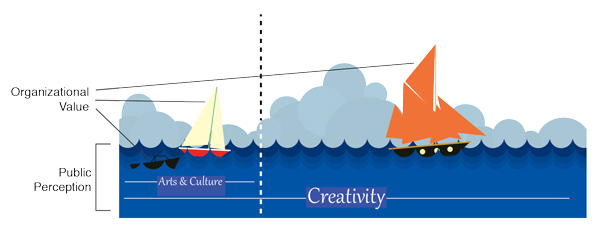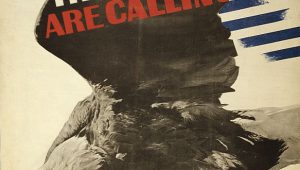This post was originally part of a weeklong exploration of four major issues facing the cultural field on our ArtsJournal blog, Field Notes. In this post, Dallas Shelby introduces the last of the problem statements.
Problem to solve: Maximize the cultural field’s value in the eyes of the public/society.
If we think of public perception as the ocean upon which our organizational value floats (see the illustration above), then as the perceived value of the field increases, so does our organizational value. It is the rising tide that lifts all boats. Global Warming aside, how do you raise the ocean level?
Public perception is a tricky thing but affecting it requires effort in at least one of two paths: talking about your value and showing your value (i.e., being valuable). The latter, while certainly not easy, is relatively straightforward. Being valuable as a field comes from the individual and collective actions taken by organizations and leaders. It’s the sum of all value. In terms of the illustration above, think of the water displacement from the weight of the boats raising the ocean level.
Measuring value.
Talking about value is a bit more difficult, particularly when talking about the value derived from the entire field. It stands to reason, though, that it should start with some understanding of what that value is. We’ve all heard and read the cases for the instrumental and the intrinsic arguments for the value we create. We live in a world obsessed with numbers. Finding meaningful (pun not intended) metrics of the field’s value can help. This too is well–worn territory and the answers are not easy.
Categories help.
Dan and Chip Heath, in their book “Made to Stick,” talk about how to craft stories that stick. Their first tenant is to keep it simple. The problem, of course, is that the value we deliver is often complex and not easy to rattle off in a simple statement. In an effort to simplify our messages we rely on existing schemas or categories. They help bridge the gaps of understanding or even empathy. I might not value what your organization does but I might value “the Arts.”
Categories limit.
If you look at the illustration again you will notice the dotted line of demarcation separating arts and culture from creativity. Think about your stakeholders, your community – do they know when they are crossing this line? Do they care? While it might be a handy shortcut to use categories to help talk about our value, they can backfire. (I might actually care about what you do but do not particularly care about “the Arts” or, worse yet, I might think “the Arts” are too stuffy.)
Regardless of the course – action or words, cultural field or creativity – if we are looking to truly create a significant wave of value we must work together. How do you define the value of the field… not just your individual organization’s value? What can you measure? What can you share? How can we work to raise the tide?



